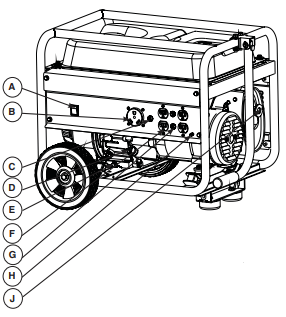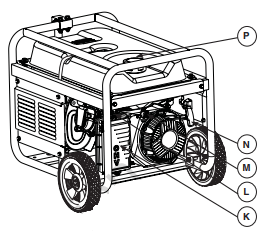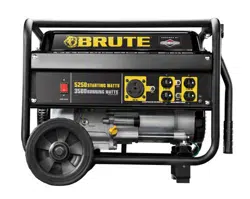Documents: Go to download!
- Owner's manual - (English, Spanish)
- Features and Controls
- Operation
- Maintenance
- Troubleshooting
Table of contents
User Manual Portable Generator
Features and Controls
Read this Operator’s Manual and safety rules before operating your generator.
Compare the illustrations with your generator, to familiarize yourself with the locations of various controls and adjustments. Save this manual for future reference.
|
A - Engine Switch — Set this switch to ON (I) before |
|
H - Grounding Fastener — Consult your local agency having jurisdiction for grounding requirements in your area. K - Air Cleaner — Protects engine by filtering dust Items Not Shown: Identification Label (on back side of control panel) — Provides model and serial number of generator. Please have these readily available if calling for assistance. |
Cord Sets and Receptacles
Use only high quality, well-insulated, grounded extension cords with the generator’s receptacles. Inspect extension cords before each use.
Check the ratings of all extension cords before you use them. Check operator’s manuals of devices to be powered for the manufacturer’s recommendations.
WARNING
Damaged or overloaded electrical cords could overheat, arc, and burn resulting in death or serious injury.
• ONLY use cords rated for your loads.
• Follow all safeties on electrical cords.
• Inspect cord sets before each use.
120 Volt AC, 30 Amp RV Outlet
Use a NEMA TT–30 plug with this receptacle. Connect a 3–wire travel trailer cord set rated for 125 Volt AC loads at 30 Amps to the plug.
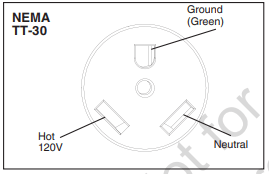
Use this receptacle to operate 120 Volt AC, 60 Hz, single phase travel trailer loads requiring up to 3,500 watts (3.5 kW) of power at 29.1 Amps. The outlet is protected by a push-to-reset circuit breaker.
NOTICE Receptacles may be marked with rating value greater than generator output capacity.
• NEVER attempt to power a device requiring more amperage than generator or receptacle can supply.
• DO NOT overload the generator. See Generator Capacity
120 Volt AC, 20 Amp, Duplex Receptacles
The duplex receptacles are protected against overload by a push to reset circuit breaker.
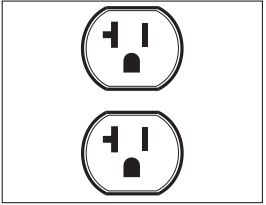
Use receptacle to operate 120 Volt AC, single–phase, 60 Hz electrical loads requiring up to 2,400 watts (2.4KW) at 20 Amps of current. Use cord sets that are rated for 125 Volt AC loads at 20 Amps (or greater).
Operation
Starting the Engine
Disconnect all electrical loads from the generator. Use the following start instructions:
1. Make sure unit is on a level surface.
NOTICE Failure to start and operate the unit on a level surface could cause the unit not to start or shut down during operation.
2. Turn the fuel valve (A) to ON (I) position.

3. Push choke lever (B) to CHOKE ( ) position.
) position.
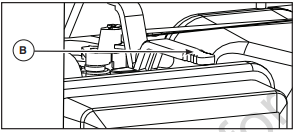
4. Push engine switch (C) to the ON (I) position.

5. Grasp recoil handle and pull slowly until slight resistance is felt. Then pull rapidly to start engine.
• If engine starts, proceed to step 7.
• If engine fails to start, proceed to step 6.
|
WARNING: Starter cord kickback (rapid retraction) will pull hand and arm toward engine faster than you can let go which could cause broken bones, fractures, bruises, or sprains resulting in serious injury. • When starting engine, pull cord slowly until resistance is felt and then pull rapidly to avoid kickback. • NEVER start or stop engine with electrical devices plugged in and turned on. |
6. Move choke lever to CHOKE ( ) position, and pull recoil handle twice.
) position, and pull recoil handle twice.
• If engine fails to start, repeat steps 5 thru 7.
7. Slowly move choke lever to RUN position ( ). If engine falters, move choke lever to half choke position until engine runs smoothly, and then to RUN position (
). If engine falters, move choke lever to half choke position until engine runs smoothly, and then to RUN position ( ).
).
NOTICE: If engine floods, place choke lever in RUN position ( ) and crank until engine starts.
) and crank until engine starts.
NOTICE: If engine starts after 3 pulls but fails to run, or if unit shuts down during operation, make sure unit is on a level surface and check for proper oil level in crankcase. This unit may be equipped with a low oil protection device. If so, oil must be at proper level for engine to start.
|
WARNING: Exhaust heat/gases could ignite combustibles, structures or damage fuel tank causing a fire, resulting in death or serious injury. Contact with muffler area could cause burns resulting in serious injury. • DO NOT touch hot parts and AVOID hot exhaust gases. • Allow equipment to cool before touching. • Keep at least 5 feet (1.5 m) of clearance on all sides of generator including overhead. • It is a violation of California Public Resource Code, Section 4442, to use or operate the engine on any forest-covered, brush-covered, or grass-covered land unless the exhaust system is equipped with a spark arrester, as defined in Section 4442, maintained in effective working order. Other states or federal jurisdictions may have similar laws. Contact the original equipment manufacturer, retailer, or dealer to obtain a spark arrester designed for the exhaust system installed on this engine. • Replacement parts must be the same and installed in the same position as the original parts. |
Connecting Electrical Loads
1. Let engine stabilize and warm up for a few minutes after starting.
2. Plug in and turn on the desired 120 Volt AC, single phase, 60 Hz electrical loads. NOTICE When plugging into the 120 Volt duplex receptacles, plug items to be powered in sequence as shown.
NOTICE When plugging into the 120 Volt duplex receptacles, plug items to be powered in sequence as shown

NOTICE
• DO NOT connect 240 Volt loads to the 120 Volt duplex receptacles.
• DO NOT connect 3-phase loads to the generator.
• DO NOT connect 50 Hz loads to the generator.
• DO NOT OVERLOAD THE GENERATOR. See Generator Capacity
NOTICE Exceeding generators wattage/amperage capacity could damage generator and/or electrical devices connected to it.
• DO NOT exceed the generator’s wattage/amperage capacity. See Generator Capacity.
• Start generator and let engine stabilize before connecting electrical loads.
• Connect electrical loads in OFF position, then turn ON for operation.
• Turn electrical loads OFF and disconnect from generator before stopping generator.
Stopping the Engine
1. Turn OFF and unplug all electrical loads from generator panel receptacles. NEVER start or stop engine with electrical devices plugged in and turned ON.
2. Let engine run at no-load for several minutes to stabilize internal temperatures of engine and generator.
3. Push engine switch to the OFF (0) position.
|
WARNING: Fuel and its vapors are extremely flammable and explosive which could cause burns, fire or explosion resulting in death or serious injury. • DO NOT stop engine by moving choke lever to CHOKE position ( |
4. Turn fuel valve lever to the OFF (0) position.
Low Oil Shutdown
If the engine oil drops below a preset level, an oil switch will stop the engine or will not allow you to start the engine. Make sure unit is on a level surface and check oil level with dipstick.
If oil level is at FULL mark on dipstick:
1. DO NOT try to restart the engine.
2. Contact an Authorized Briggs & Stratton Service Dealer.
3. DO NOT operate engine until oil level is corrected.
If oil level is below FULL mark on dipstick:
1. Add oil to bring level to FULL mark.
2. Restart engine and if the engine stops again a low oil condition may still exist. DO NOT try to restart the engine.
3. Contact an Authorized Briggs & Stratton Service Dealer.
4. DO NOT operate engine until oil level is corrected.
Generator Capacity
To make sure your generator can supply enough running watts and starting watts for the items you will power at the same time, follow these simple steps:
1. Select the items you will power at the same time. See following list for typical wattages.
| Tool or Appliance | Running Watts* | Starting Watts** |
| Light Bulb - 75 Watt | 75 | - |
| Sump Pump | 800 | 1200 |
| Refrigerator/Freezer | 800 | 2000 |
| Water Well Pump - 1/3 HP | 1000 | 2000 |
| Window AC - 10,000 BTU | 1200 | 1800 |
| Furnace Fan Blower - 1/2 HP | 800 | 1300 |
| Microwave Oven - 1000 Watt | 1000 | - |
| Color Television - 42” | 280 | - |
| Personal Computer w/17” monitor | 800 | - |
| Garage Door Opener - 1/2 HP | 480 | 520 |
* Typical wattages listed are approximate only. Check tool or appliance for actual wattage.
** Per Briggs & Stratton 628K, Starting Watts represents the momentary electrical current the generator can provide to start electric motors. Starting Watts does not represent the power required to continuously run electrical loads. Starting Watts is the maximum current that can momentarily be supplied when starting a motor, multiplied by the generator’s rated voltage.
2. Total the running watts. This is the amount of power your generator must produce to keep your items running. See following example:
Example
| Tool or Appliance | Running Watts | Starting Watts |
| Window air conditioner | 1200 | 1800 |
| Refrigerator | 800 | 2000 |
| Television | 280 | - |
| Light (75 Watts) | 75 | - |
| 2355 Total Running Watts | 2000 Highest Starting Watts |
Total running watts = 2355
Highest starting watts = 2000
Total generator watts required = 4355
3. Estimate the starting watts you will need. Because not all motors start at the same time, total starting wattage can be estimated by adding only the item with the highest additional starting watts requirements to the total running watts from step 2.
Power Management
To manage generator power, sequentially add loads as follows:
1. With nothing connected to generator, start the engine outdoors.
2. Plug in and turn on the first load, preferably the largest load you have.
3. Permit the generator output to stabilize (engine runs smoothly and attached device operates properly).
4. Plug in and turn on the next load.
5. Again, permit the generator to stabilize.
6. Repeat steps 4 and 5 for each additional load.
Never add more loads than the generator capacity.
Take special care to consider surge loads in generator capacity.
Maintenance
Follow the hourly or calendar intervals, whichever occurs first. More frequent service is required when operating in adverse conditions noted below.
| First 5 Hours |
| • Change engine oil |
| Every 8 Hours or Daily |
| • Clean debris |
| • Check engine oil level |
| Every 50 Hours or every season |
| • Clean/Replace air filter1 |
| Every 100 Hours or every season |
| • Change oil1 |
| • Change/Adjust spark plug |
| • Clean spark arrester |
| • Service fuel valve |
* Service more often under dirty or dusty conditions.
General Recommendations
Regular maintenance will improve the performance and extend the life of the generator. See any authorized dealer for service.
The generator’s warranty does not cover items that have been subjected to operator abuse or negligence. To receive full value from the warranty, the operator must maintain the generator as instructed in this manual.
NOTICE Improper treatment of generator could damage it and shorten its life.
• NEVER operate generator without protective housing or covers to assure proper cooling.
Some adjustments will need to be made periodically to properly maintain your generator.
All service and adjustments should be made at least once each season. A new spark plug and clean air filter assure proper fuel-air mixture and help your engine run better and last longer. Follow the requirements in the Maintenance Schedule chart above.
Emissions Control
Maintenance, replacement, or repair of the emissions control devices and systems may be performed by any non-road engine repair establishment or individual. However, to obtain ”no charge” emissions control service, the work must be performed by a factory authorized dealer. See the Emissions Warranty.
Generator Maintenance
Generator maintenance consists of keeping the unit clean and dry. Operate and store the unit in a clean dry environment where it will not be exposed to excessive dust, dirt, moisture, or any corrosive vapors. Cooling air slots in the generator must not become clogged with snow, leaves, or any other foreign material.
NOTICE DO NOT use water or other liquids to clean generator. Liquids can enter engine fuel system, causing poor performance and/or failure to occur. In addition, if liquid enters generator through cooling air slots, some of the liquid will be retained in voids and cracks of the rotor and stator winding insulation. Liquid and dirt buildup on the generator internal windings will eventually decrease the insulation resistance of these windings.
Cleaning
Daily or before use, look around and underneath the generator for signs of oil or fuel leaks. Clean accumulated debris from inside and outside the generator. Keep the linkage, spring and other engine controls clean. Keep the area around and behind the muffler free from any combustible debris. Inspect cooling air slots and openings on generator. These openings must be kept clean and unobstructed.
Engine parts should be kept clean to reduce the risk of overheating and ignition of accumulated debris:
• Use a damp cloth to wipe exterior surfaces clean.
NOTICE Improper treatment of generator could damage it and shorten its life.
• DO NOT expose generator to excessive moisture, dust, dirt, or corrosive vapors.
• DO NOT insert any objects through cooling slots.
• Use a soft bristle brush to loosen caked on dirt or oil.
• Use a vacuum cleaner to pick up loose dirt and debris.
Fuel Valve Maintenance
The fuel valve is equipped with a fuel sediment cup, screen, and o-ring that need to be cleaned.
1. Move fuel valve to OFF (0) position.
2. Remove sediment cup (A) from fuel valve. Remove o-ring (B) and screen (C) from fuel valve.

3. Wash sediment cup, o-ring, and screen in a nonflammable solvent. Dry them thoroughly.
4. Place screen and o-ring into fuel valve. Install sediment cup and tighten securely.
5. Move fuel valve to ON (I) position, and check for leaks. Replace fuel valve if there is any leakage.
Engine Maintenance
WARNING Unintentional sparking could cause fire or electric shock resulting in death or serious injury. WHEN ADJUSTING OR MAKING REPAIRS TO YOUR GENERATOR • Disconnect the spark plug wire from the spark plug and place the wire where it cannot contact spark plug. WHEN TESTING FOR ENGINE SPARK • Use approved spark plug tester. • DO NOT check for spark with spark plug removed. Oil Oil Recommendations We recommend the use of Briggs & Stratton Warranty Certified oils for best performance. Other high-quality detergent oils are acceptable if classified for service SF, SG, SH, SJ or higher. DO NOT use special additives. Outdoor temperatures determine the proper oil viscosity for the engine. Use the chart to select the best viscosity for the outdoor temperature range expected.
|
WARNING: Unintentional sparking could cause fire or electric shock resulting in death or serious injury. WHEN ADJUSTING OR MAKING REPAIRS TO YOUR GENERATOR • Disconnect the spark plug wire from the spark plug and place the wire where it cannot contact spark plug. WHEN TESTING FOR ENGINE SPARK • Use approved spark plug tester. • DO NOT check for spark with spark plug removed.
|
Oil
Oil Recommendations
We recommend the use of Briggs & Stratton Warranty Certified oils for best performance. Other high-quality detergent oils are acceptable if classified for service SF, SG, SH, SJ or higher. DO NOT use special additives.
Outdoor temperatures determine the proper oil viscosity for the engine. Use the chart to select the best viscosity for the outdoor temperature range expected.
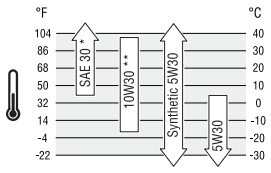
* Below 40°F (4°C) the use of SAE 30 will result in hard starting.
** Above 80°F (27°C) the use of 10W30 may cause increased oil consumption. Check oil level more frequently.
Checking Oil Level
Oil level should be checked prior to each use or at least every 8 hours of operation. Keep oil level maintained.
1. Make sure generator is on a level surface.
2. Clean area around oil fill, remove oil cap/dipstick and wipe dipstick with clean cloth. Replace dipstick. Remove and check oil level.
NOTICE DO NOT screw in dipstick when checking oil level.
3. Verify oil is at full mark (D) on dipstick. Replace and tighten oil cap/dipstick.

Adding Engine Oil
1. Make sure generator is on a level surface.
2. Check oil level as described in Checking Oil Level.
3. If needed, slowly pour oil into oil fill opening to the full mark on dipstick. DO NOT overfill.
NOTICE Overfilling with oil could cause the engine to not start, or hard starting.
• DO NOT overfill.
• If over the FULL mark on dipstick, drain oil to reduce oil level to FULL mark on dipstick.
4. Replace and tighten oil cap/dipstick.
Changing Engine Oil
If you are using your generator under extremely dirty or dusty conditions, or in extremely hot weather, change the oil more often.
|
CAUTION: Avoid prolonged or repeated skin contact with used motor oil. • Used motor oil has been shown to cause skin cancer in certain laboratory animals. • Thoroughly wash exposed areas with soap and water. |
|
|
|
KEEP OUT OF REACH OF CHILDREN. DON’T POLLUTE. CONSERVE RESOURCES. RETURN USED OIL TO COLLECTION CENTERS. |
Change the oil while the engine is still warm from running, as follows:
1. Make sure unit is on a level surface.
2. Disconnect the spark plug wire from the spark plug and place the wire where it cannot contact spark plug.
3. Clean area around oil drain plug (A). The oil drain plug is located at base of engine, opposite carburetor. A
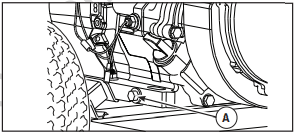
4. Remove oil drain plug and drain oil completely into a suitable container.
5. Reinstall oil drain plug and tighten securely. Remove oil cap/dipstick.
6. Slowly pour recommended oil (about 20 oz. (0.6 l)) into oil fill opening. Pause to permit oil to settle. Fill to the full mark on dipstick.
7. Wipe dipstick clean each time oil level is checked. DO NOT overfill.
8. Reinstall oil cap/dipstick. Tighten cap securely.
9. Wipe up any spilled oil.
Service Air Filter
Your engine will not run properly and may be damaged if you run it with a dirty air filter. Clean or replace more often if operating under dusty or dirty conditions.
To service the air filter, follow these steps:
1. Unclamp latches (B) that hold on the cover (C).
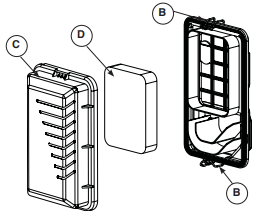
2. Remove cover and foam air filter (D).
3. Wash the foam air filter in liquid detergent and water. Squeeze dry the foam air filter in a clean
cloth.
4. Saturate the foam air filter with clean engine oil.
To remove the excess engine oil, squeeze the ffoam air filter in a clean cloth.
5. Reinstall clean or new foam air filter (D).
6. Reinstall the air filter cover and clamp latches.
Service Spark Plug
Changing spark plug will help your engine to start easier and run better.
1. Clean area around spark plug.
2. Remove and inspect spark plug.
3. Replace spark plug if electrodes are pitted, burned or porcelain is cracked. Use the recommended
replacement spark plug. See Specifications.
4. Check electrode gap with wire feeler gauge and reset spark plug gap to recommended gap if necessary (see Specifications).
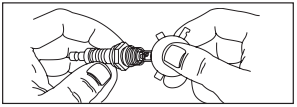
5. Install spark plug and tighten firmly
Inspect Muffler and Spark Arrester
Inspect the muffler for cracks, corrosion, or other damage. Remove the spark arrester, if equipped, and inspect for damage or carbon blockage. If replacement parts are required, make sure to use only original equipment replacement parts.
|
WARNING: Exhaust heat/gases could ignite combustibles, structures or damage fuel tank causing a fire, resulting in death or serious injury. Contact with muffler area could cause burns resulting in serious injury. • DO NOT touch hot parts and AVOID hot exhaust gases. • Allow equipment to cool before touching. • Keep at least 5 feet (1.5 m) of clearance on all sides of generator including overhead. • It is a violation of California Public Resource Code, Section 4442, to use or operate the engine on any forest-covered, brush-covered, or grass-covered land unless the exhaust system is equipped with a spark arrester, as defined in Section 4442, maintained in effective working order. Other states or federal jurisdictions may have similar laws. Contact the original equipment manufacturer, retailer, or dealer to obtain a spark arrester designed for the exhaust system installed on this engine. • Replacement parts must be the same and installed in the same position as the original parts. |
Clean or replace spark arrester as follows:
1. Allow the engine to cool completely before servicing the spark arrester.
2. Remove the two screws (A) holding the cover plate (B) which retains the end of the spark arrester (B) to the muffler (D).
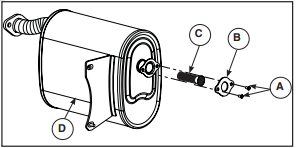
3. Remove the spark arrester screen.
4. Carefully remove the carbon deposits from the spark arrester screen with a wire brush.
5. Replace the spark arrester if it is damaged.
6. Position the spark arrester in the muffler and attach the cover plate with the two screws.
Storage
The generator should be started at least once every seven days and allowed to run at least 30 minutes. If this cannot be done and you must store the unit for more than 30 days, use the following guidelines to prepare it for storage.
Generator Storage
• Clean the generator as outlined in Cleaning.
• Check that cooling air slots and openings on generator are open and unobstructed.
Long Term Storage Instructions
Fuel can become stale when stored over 30 days. Stale fuel causes acid and gum deposits to form in the fuel system or on essential carburetor parts. To keep fuel fresh, use Briggs & Stratton® Advanced Formula Fuel Treatment & Stabilizer, available wherever Briggs & Stratton genuine service parts are sold.
There is no need to drain gasoline from the engine if a fuel stabilizer is added according to instructions. Run the engine for 2 minutes to circulate the stabilizer hroughout the fuel system before storage.
If gasoline in the engine has not been treated with a fuel stabilizer, it must be drained into an approved container. Run the engine until it stops from lack of fuel. The use of a fuel stabilizer in the storage container is recommended to maintain freshness.
|
WARNING:Fuel and its vapors are extremely flammable and explosive which could cause burns, fire or explosion resulting in death or serious injury. WHEN STORING FUEL OR EQUIPMENT WITH FUEL IN TANK • Store away from furnaces, stoves, water heaters, clothes dryers or other appliances that have pilot light or other ignition source because they could ignite fuel vapors. WHEN DRAINING FUEL • Turn generator engine OFF and let it cool at least 2 minutes before removing fuel cap. Loosen cap slowly to relieve pressure in tank. • Drain fuel tank outdoors. • Keep fuel away from sparks, open flames, pilot lights, heat, and other ignition sources. • Check fuel lines, tank, cap and fittings frequently for cracks or leaks. Replace if necessary. • DO NOT light a cigarette or smoke. |
Change Engine Oil
While engine is still warm, drain oil from crankcase. Refill with recommended grade. See Changing Engine Oil.
Other Storage Tips
1. DO NOT store fuel from one season to another unless it has been treated as described in Long Term Storage Instructions.
2. Replace fuel container if it starts to rust. Rust and/ or dirt in fuel can cause problems if it’s used with this unit.
3. Cover unit with a suitable protective cover that does not retain moisture.
|
WARNING: Storage covers could cause a fire resulting in death or serious injury. WHEN STORING FUEL OR EQUIPMENT WITH FUEL IN TANK • • DO NOT place a storage cover over a hot generator. • Let equipment cool for a sufficient time before placing the cover on the equipment |
4. Store generator in clean, dry area.
Troubleshooting
| Problem | Cause | Correction |
| Engine is running, but no AC output is available. | 1. Circuit breaker is open. 2. Fault in generator. 3. Poor connection or defective cord set. 4. Connected device is bad. |
1. Reset circuit breaker. 2. Contact authorized service facility. 3. Check and repair. 4. Connect another device that is in good condition. |
| Engine runs good at no-load but “bogs down” when loads are connected. |
1. Short circuit in a connected load. 2. Engine speed is too slow. 3. Generator is overloaded. 4. Shorted generator circuit. |
1. Disconnect shorted electrical load. 2. Contact authorized service facility. 3. See Generator Capacity. 4. Contact authorized service facility. |
| Engine will not start; starts and runs rough or shuts down when running. |
1. Engine switch set to OFF (0) position. 2. Fuel shutoff lever is in OFF (0) position. 3. Low oil level. 4. Dirty air cleaner. 5. Out of fuel. 6. Stale fuel. 7. Spark plug wire not connected to spark plug. 8. Bad spark plug. 9. Water in fuel. 10. Flooded. 11. Excessively rich fuel mixture. 12. Intake valve stuck open or closed. 13. Engine has lost compression. |
1. Set engine switch to ON (I) position. 2. Move fuel shutoff lever to ON (I) position. 3. Fill crankcase to proper level or place generator on level surface. 4. Clean or replace air cleaner. 5. Fill fuel tank. 6. Drain fuel tank and carburetor; fill with fresh fuel. 7. Connect wire to spark plug. 8. Replace spark plug. 9. Drain gas tank and carburetor; fill with fresh fuel. 10. Wait 5 minutes and re-crank engine. 11. Contact authorized service facility. 12. Contact authorized service facility. 13. Contact authorized service facility. |
| Engine lacks power. | 1. Load is too high. 2. Dirty air filter. |
1. See Generator Capacity. 2. Replace air filter. |
| Engine “hunts” or falters. | Carburetor is running too rich or too lean. | Contact authorized service facility. |
